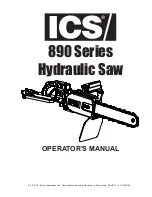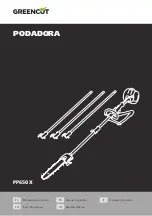
15
4.
Compound cutting
Compound cutting is the process in which a bevel
angle is made at the same time in which a miter
angle is being cut on a workpiece. Compound cut-
ting can be performed at angle shown in the table
below.
At the miter angle of left 45° and bevel angle of left
45°, workpieces 45 mm high x 85 mm wide can be
cut. When performing compound cutting, refer to
“Press cutting”, “Miter cutting” and “Bevel cut” expla-
nations.
5.
Cutting repetitive lengths
(Fig. 29)
When cutting several pieces of stock to the same
length, ranging from 220 mm to 365 mm, use of the
set plate (optional accessory) will facilitate more effi-
cient operation. Install the set plate on the holder as
shown in
Fig. 29
. Align the cutting line on your work-
piece with either the left or right side of the groove in
the kerf board, and while holding the workpiece from
moving, move the set plate flush against the end of
the workpiece. Then secure the set plate with the
screw. When the set plate is not used, loosen the
screw and turn the set plate out of the way.
NOTE:
Use of the holder-rod assembly (optional accessory)
allows cutting repetitive lengths, ranging from
220 mm to 2,230 mm.
Carrying tool (Fig. 4 & 30)
Make sure that the battery cartridge is removed. Secure
the blade at 0° bevel angle and the turn base at 52° miter
angle to the right. Lower the handle fully and lock it in the
lowered position by pushing in the stopper pin. Carry the
tool by the carrying grip as shown in
Fig. 30
.
MAINTENANCE
CAUTION:
Always be sure that the tool is switched off and the bat-
tery cartridge is removed before carrying out any work on
the tool.
Adjusting the cutting angle
This tool is carefully adjusted and aligned at the factory,
but rough handling may have affected the alignment. If
your tool is not aligned properly, perform the following:
1.
Miter angle
Loosen the grip which secures the turn base. Turn
the turn base so that the pointer points to 0° on the
miter scale. Then turn the turn base slightly clock-
wise and counterclockwise to seat the turn base
cozily in the 0° miter notch. (Leave as it is if the
pointer does not point to 0°.) Loosen the four hex
bolts securing the guide fence using the socket
wrench.
(Fig. 31)
Lower the handle fully and lock it in the lowered posi-
tion by pushing in the lock pin. Square the side of the
blade with the face of the guide fence using a trian-
gular rule, try square, etc. Then securely tighten the
hex bolts on the guide fence in the order from right
side.
(Fig. 32)
Make sure that the pointer points to 0° on the miter
scale. If the pointer does not point to 0°, loosen the
screw which secures the pointer and adjust the
pointer so that it will point to 0°.
(Fig. 33)
2.
Bevel angle
i) 0° bevel angle
Lower the handle fully and lock it in the lowered
position by pushing in the lock pin. Loosen the
lever at the rear of the tool. Turn the 0° bevel
angle adjusting bolt (lower bolt) on the right side
of the arm two or three revolutions counterclock-
wise to tilt the blade to the right.
(Fig. 34)
Carefully sqaure the side of the blade with the top
surface of the turn base using the triangular rule,
try square, etc. by turning the 0° bevel angle
adjusting bolt clockwise. Then tighten the lever
securely.
(Fig. 35)
Make sure that the pointer on the sub arm points
to 0° on the bevel scale on the arm. If it does not
point to 0°, loosen the screw which secures the
pointer and adjust the pointer so that it will point
to 0°.
(Fig. 36)
ii) 45° bevel angle
Adjust the 45° bevel angle only after performing
0° bevel angle adjustment. To adjust left 45° bevel
angle, loosen the lever and tilt the blade 45° to the
left. Make sure that the pointer on the sub arm
points to 45° on the bevel scale on the arm. If the
pointer does not point to 45°, turn the 45° bevel
angle adjusting bolt (upper bolt) on the right side
of the arm until the pointer points to 45°.
(Fig. 34)
Replacement of carbon brushes (Fig. 37 & 38)
Remove and check the carbon brushes regularly.
Replace when they wear down to the limit mark. Keep
the carbon brushes clean and free to slip in the holders.
Both carbon brushes should be replaced at the same
time. Use only identical carbon brushes.
Use a screwdriver to remove the brush holder caps. Take
out the worn carbon brushes, insert the new ones and
secure the brush holder caps.
To maintain product safety and reliability, repairs, mainte-
nance or adjustment should be carried out by a Makita
Authorized Service Center.
Miter angle
Bevel angle
Left and right 45°
Left 0° – 45°
Left and right 52°
Left 0° – 40°
Содержание BLS820
Страница 2: ...2 1 2 3 4 5 6 7 8 1 3 4 5 6 7 8 9 9 5 10 11 13 12 5 14 15 7 16 18 17 15 19 2 1 ...
Страница 3: ...3 23 17 23 24 25 27 26 28 30 27 29 9 10 11 12 13 14 15 16 12 22 20 21 5 7 15 14 5 11 10 12 13 ...
Страница 5: ...5 51 52 53 54 55 57 56 44 27 58 59 25 26 27 28 29 30 31 32 ...
Страница 6: ...6 59 17 30 32 31 60 39 64 40 63 61 62 35 65 67 66 33 34 35 36 37 38 ...
Страница 108: ...Makita Corporation Japan 884307B997 ...
















































